Building a Stud Wall Cost
Last updated 18th July, 2025
Installing a stud partition wall is a really smart way to create an extra room in your home without extensive expansion.
Thankfully, if you have decent DIY skills, you can install a partition wall yourself.
Below we’ll consider the average cost (usually between £800 and £900) to fit a stud wall and all the other costs associated with stud wall construction.
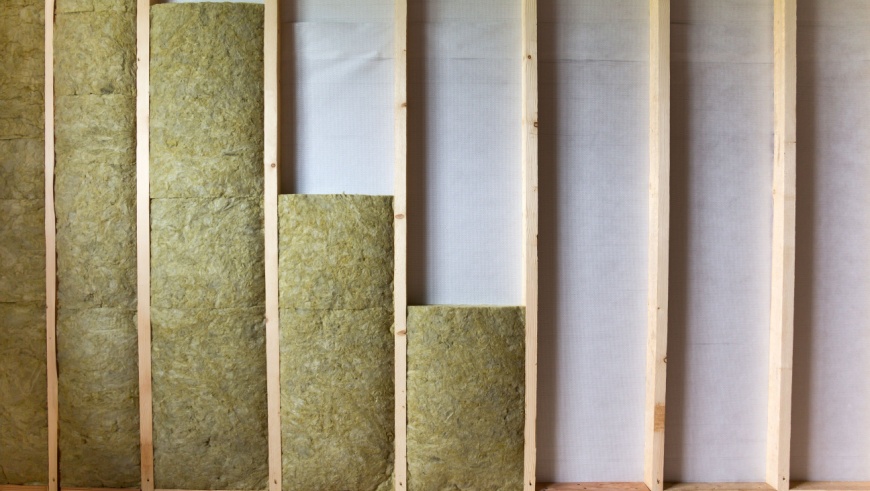
Table of contents
- How much does a stud wall cost?
- Additional costs of a stud wall
- Labour costs to install a stud wall
- What is a stud wall?
- What impacts how much building a stud wall costs?
- Stud wall insulation cost
- What does installing stud walls involve?
- DIY stud wall installation
- Benefits of installing a stud wall
- Timber stud wall vs steel stud wall
- Building regulations for stud walls
- Cost of stud wall removal
- FAQs
- How to find and hire a stud wall installer
- Sources
How Much Does a Stud Wall Cost?
Let’s get down to the nitty-gritty. How much does a stud wall cost?
Well, like most people, you might prefer to get a handyman to deal with the issue in which case you should consider labour and material costs.
Generally speaking, a professional will charge you between £800 and £900 to install an average stud wall, and the job should take about 2 to 3 days.
However, this is assuming there are no other charges to consider, and there is no other major job to do.
What factors can affect the cost of a partition wall?
There are several factors that could change the stud wall price such as the number of stud walls you want.
For instance, if you have a very large room and want to divide it into three smaller rooms rather than two, then you can imagine you’ll need an extra stud wall which will cost extra.
Furthermore, things like electrical fittings and radiator installation are also factors that could increase the price of the project.
Also, there are less evident factors that could affect the cost, like the location of your property.
This means that the further a carpenter or contractor has to travel to reach you, the more you are likely to pay.
What's more, the size and location of your stud wall might be factored into the total price, so larger rooms will cost more as they require more material.
On top of that...
If the location you want your stud wall installed is difficult to access or there are other factors that could make the job of the professional more challenging, then you can expect that this will also come out of your pocket.
With all of that said, you might want something a little more specific in which case you should consider the stud wall cost per m² which should come to about £2 to £5.
With all these considerations, you should have a better idea about how you want to go about sorting out your stud walls!
Stud Wall Price List
For a deeper dive into how much you might need to spend to get your stud walls up and running, you should examine the table below.
| JOB DESCRIPTION | PRICE | DURATION |
|---|---|---|
| Installing a stud wall | £800 | 2 - 3 days |
| Stud wall with radiator | £1,000 | 3 - 4 days |
| Stud wall with radiator and light fitting | £1,125 | 3 - 4 days |
| Two stud walls | £1,500 | 2 - 4 days |
Additional Costs of a Stud Wall
Now that you know the cost to build a stud wall, we can examine a few other considerations that could cost extra.
While we have considered some of the above, including the ease of access, location of the property, size of the wall, and so on, the costs don’t end there.
There are other things to consider that directly affect the room(s) you’re renovating.
Painting
One example is painting since you won’t want your wall bare once it is installed.
For several people, they go down the DIY route to save money on the project.
However, not everyone has that luxury of time, so if you’re a busy person with no time to do it yourself, or just not skilled in doing it yourself, then you can always hire a painter to do the job.
The typical cost of painting a room is around £250 to £300 for an average-sized room.
You should note that the price given for painting a room is based on the assumption that the room is average-sized and has been prepared for the painter with no obstructions.
But, if the contractor has to strip the room or move furniture around, you can expect to pay around £300 to £550 for labour.
There are also other costs to consider including the size of the room, the amount of paint used, ease of access, and so on.
Moreover, if you are dividing one room into three, and you want to paint all the walls, that will also increase the price.
As mentioned before, the size of the room is also important to note as a painter will probably need some help if the job is much larger than usual in which case you’ll need to also consider the other person.
Thankfully, the job doesn’t take up too much time and can be done in about 3 to 4 hours.
The painter is likely to come around the next day to add a second layer of paint, and for this reason, it is wise to have more than one room done as this saves you money in the long run.
Plastering
This is another important part of the renovation process as this helps to further protect the walls and make it easier to decorate.
On average, the cost to plaster a room is about £100 to £200 for a job which should take less than six hours.
But, just like other jobs, there are a few factors that could increase the price, including the size of the job and the location of the property.
For instance, if the whole room needs to be plastered, then it should cost about £300 to £400.
Meanwhile, if you want two rooms plastered, then you can budget around £500 to £600 for the job which might take a day or two.
However, if it’s only a small patch of the wall that needs a fix, then the job is a lot cheaper, but since there’s a minimum fee to be paid, you will pay between £100 and £120.
Plasterboard or drywall may be another option and it is usually easier to install. Again, the plasterboard cost will depend on minimum fees as well as how big the wall is.
Skirting Boards
Don't overlook the fact that your new studded wall will need skirting boards to fit in with the rest of the room.
Given that installing fresh skirting on the new wall may make it stand out from the other walls, it could be worth installing fresh boards around the whole room.
On average, the cost to replace skirting boards is between £300 and £500, but this depends on the size of the room and where you are in the UK.
Stud Wall Cost Breakdown Calculator
Individual cost for installing a stud wall - Total Cost: £800
Materials
£260
Tradesmen
£540
Waste Removal
£0
Labour Costs to Install a Stud Wall
Installing a stud wall is a labour-intensive job and can take anywhere from 3 to 4 days.
This is with the assumption that you're working on an average-sized wall, as certain factors can increase the amount of time that the job takes.
For instance, allowing for the installation of a door or radiator costs around £1,000 to £1,200 and you will have to allow slightly long for it to be completed
Meanwhile, if you wish to have light fittings also installed, this can cost £1,125 to £1,300 depending on the fixtures and fittings you have requested and may need the assistance of a qualified electrician.
There are also other things to take into consideration, including the size and number of stud walls being installed. For example, if you require two stud walls, this should cost around £1,500 to £1,600 and will take an additional couple of days.
Do You Need a Structural Engineer?
Many stud walls are non-load bearing, so there will generally be no need for a structural engineer to be involved in the planning process.
However, if a partition wall is intended to support another part of the structure such as the roof or a floor, you'll need to consider whether a structural engineer is required.
For example, if you're making multiple changes to your property and perhaps removing or altering several walls, you may risk damaging the structural integrity of your home.
The cost of a structural engineer will vary depending on what work is needed. A survey to assess if there's any risk to your property from your development plans will usually cost between £500 and £1,500.
As involving a structural engineer can increase the expense of the job, it can be worth considering whether you should build a stud wall or if you need something more substantial.
What is a Stud Wall?
In the simplest terms, a stud is a vertical framing member which constitutes a part of a wall.
They function to support and protect the wall and are generally made of timber.
That said, there are wooden and steel stud walls.
While wooden stud walls are more popular and cheaper, steel studs have become increasingly trendy for homeowners.
Furthermore, the walls come in two common dimensions: 1-1/2 inches X 3-1/2 inches, otherwise known as two-by-fours and 1-1/2 inches X 5-1/2 inches also called two-by-sixes.
Also, you can easily purchase them up to 16 feet from just about any supply or building store.
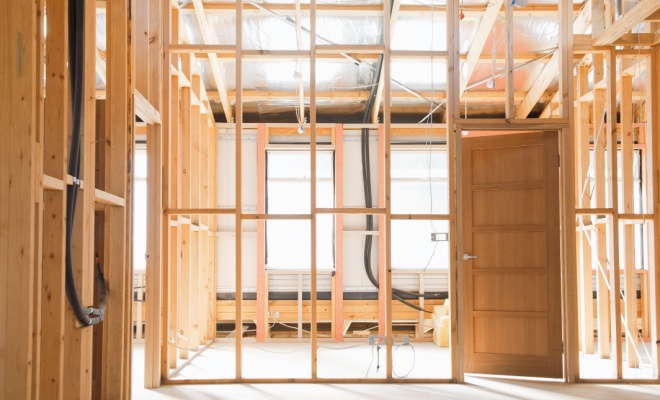
As to how they work, studs are usually installed at a 90-degree angle to the wall to strengthen the wall while also creating adequate space for the placement of wires, pipes, and insulation.
Studs are also placed between the top and bottom plates which are then screwed to the stud’s ends.
Moreover, studs are evenly spaced either at 16 or 24 inches for the sake of uniformity and also to line up perfectly with the ends of sheet materials.
Stud walls have been in use for quite a while and aren’t too expensive to put up, especially if you want to do it yourself.
What Impacts How Much Building a Stud Wall Costs?
As mentioned earlier, the typical stud partition wall cost with no attachments or extra installations should cost somewhere in the region of £800 to £900.
However, there are several factors that could affect the end cost.
Size of the Wall
The size of the stud wall is a key factor, and this should be reflected in the cost issued within the quote and any estimated timeframes provided for completing the job.
Larger walls naturally require additional materials, and may well need more than one tradesmen to carry out the work. If this is the case, labour fees can increase and if the wall requires a little more attention it could add an extra day to the timeframe before you can use the room again.
Number of Stud Walls
If you have a large room that you're looking to have partitioned into three spaces rather than two, this will take longer and likely come with additional labour fees as a result.
Likewise, if you're having more than one room done at the same time, you should expect to pay for either extra workers or anticipate the job taking longer.

Ease of Access
Before a stud wall is installed, there needs to be some preperation done first to make the area as accessible as possible. Some of this can be carried out by yourself in order to keep costs down:
- Clear furniture or obstacles from the room
- If not possible, then cover with dust sheets
- Remove light fixtures or electrical fittings
- Ensure pets are kept out of the way
Location of Property
Whereabouts you are located within the country can also impact costs. For example, prices can fluctuate in areas such as London and the South East due to the higher cost of living.
Some tradesmen may include travel expenses in the event of visiting remote or hard to reach destinations.
Stud Wall Insulation Cost
It might become necessary to insulate your stud wall, costing around £30 to £40 per m²,but this is usually done when other methods are impossible.
Hence, professionals will fill the space between the grid and the wall insulation material.
Then, plasterboard is attached to the frame to act as a wall material.
Apart from using stud walls, insulation can also be achieved through cavity and external wall insulation.
What Does Installing Stud Walls Involve?
So, if you are looking to build a stud wall yourself, or want to have an idea of what your handyman is doing while installing the stud wall, here is a guide to all the steps involved in the creation of the wall.
It shouldn’t be too difficult to keep up all you need to do is pay close attention to the following steps, and you will have no problem tackling the project, or at least you will not be confused by what the professional is doing.
What Will You Need?
As with every other project on the face of the earth, you need to first collect all the pertinent materials before you get to work.
This includes timbers, braces and so on. If a professional is handling it, then you don’t need to worry about the materials.
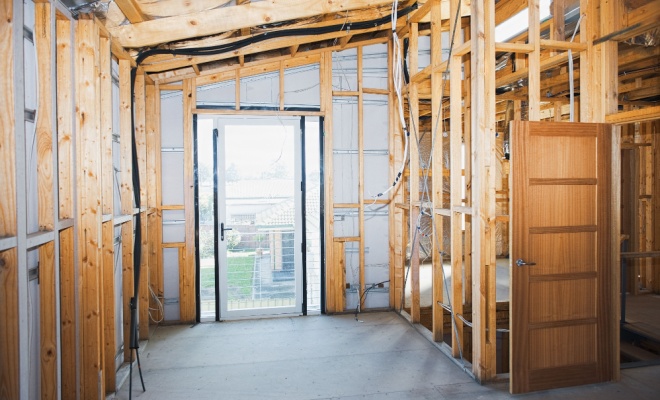
But just for knowledge's sake, your handyman will probably have timber, nails, frames, power tools, and so on.
Prepping
The next thing the professional will do is to take the necessary measurements to know the length of the wall.
This step might also be taken before gathering the necessary materials to ensure that you buy the right amount of materials as this will prevent a situation where you are left stranded with only part of the wall finished and no resources to continue the job.
Next, the professional will check the floor and ceiling to ensure that they are level; this is to ensure that there are no gaps that require fixing.
The preparation process also includes getting rid of electrical outlets and other hindrances that could affect the new wall.
This could also include light fixtures and so on and you should note that this will likely cost you more money.
Pay close attention to the person working on the wall to ensure that the wall is fastened to the bare floor.
This will prevent your wall from shifting and becoming unstable.
Set Up Support Joists
Once all the prep work is done, the contractor can begin.
The first thing to be done is to mark the position of any existing studs to determine if the wall can be securely fastened.
Then checking to determine the position of the floor joists is also important as this ensures that the wall is supported by the joists below.
If the floor joists are in place, then the job becomes a lot easier.
If not, then new ones will need to be implemented to provide adequate support for the new wall.
Floorplates
The floor plate comes next, and it is installed once you cut up the timber to the length of your floor.
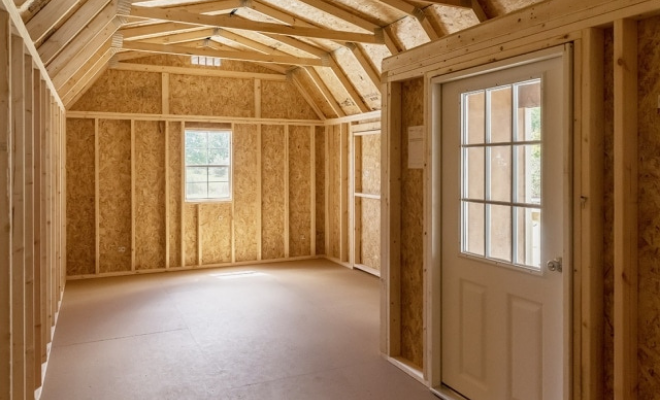
Then, it is nailed down to the joists to provide adequate support and provide sturdiness.
However, if you are going to add a door, the contractor might just put in a nail as it’ll be removed later to make way for the door.
Ceiling
As mentioned earlier, wall studs are sandwiched between a floor and ceiling portion, and they provide a frame for the wall which secures it steadily.
Getting the Studs Set Up
With the borders set and ready to go, the next step is the placement of the vertical studs.
Each stud is measured individually so that it fits perfectly into its designated slot.
Installing Noggins
Noggins are horizontal items that run parallel with the top and bottom plates between the studs.
They function to provide extra strength for the wall’s centre. Therefore, they’ll need to be installed if the wall is to serve adequately.
So, each noggin is measured carefully and installed between each stud.
Doorway Section
This is an optional feature as you might now want a door with the new wall.
If necessary, note that it will cost you extra, but it doesn’t take too much work as the handyman will simply cut out any unnecessary section from the doorway.
Then the door will be installed in the centre, and the nail used to hold down the joist in that area will be removed.
In some cases, the contractor might use the extra bits from the doorway as a header piece.
It should be noted that all the steps above will look slightly different if you are setting up a steel stud wall.
This is because not only is steel more expensive, but it is also a bit more challenging to cut.
Also, the studs are placed into specially made tracks to hold them together.
DIY Stud Wall Installation
DIY is a great option when trying to save some money on the installation of a stud wall.
However, you need to ensure that you have the basic knowledge necessary before pulling it off.
You can undertake the entire process of building a new wall, and all you’ll really need from a legal standpoint is approval under the Building Regulations 2000.
This is to ensure that there is adequate space between the new habitable area and the remainder.
Also, in the case of a new door, you should check whether it needs to be fire-resistant and self-closing.
Once these two are determined, you should have no problems.
As mentioned earlier, DIY saves a lot of money with most of your spending going instead towards the materials you’ll need to buy.

Speaking of materials, the wood for a timber stud wall cost should be around £2 to £5 per m² (prior to insulating), and depending on the size of the wall, you might not need to spend too much.
But, if you aren’t confident in your building skills, it might be best to leave this to the professionals as this could be a cheaper option in the long run.
For instance, if the wall isn’t properly installed, it could constitute a hazard, or it might not get the necessary approval which will then require you to get a professional to install it and cost more.
If your building skills are inadequate, but you still want to save some money, you can start the prepping process before the arrival of the professional.
This could include clearing out the room to engender easy access to the wall.
Also, if you can remove any light fixtures or electrical outlets, this could also reduce the amount of money you’ll need to stump up.
Finally, if you want metal stud walls, these are a lot trickier, and there is an even smaller margin for error.
Therefore, if you can get a professional, it is best to do so to avoid any unfortunate circumstances.
Benefits of Installing a Stud Wall
Having stud walls in your home is a great idea, and there are a couple of advantages attached to it that you should consider.
- Cost Effective - It's much cheaper than building a solid wall or extension
- Standard Materials - Everything needed is readily available from the wholesaler
- Quick to install - Less labour-intensive than a standard wall within minimal disruption
- Lightweight - As such not as much worry regarding suitable flooring
- Flexible Design - Ideal for creating internal spaces
- Easy and Convenient - Great for routing electrical cables or pipework
- Suitable for Decorating - Smooth finish ideal for painting, wallpaper or plasterboard
Timber Stud Wall vs Steel Stud Wall
While timber is ever popular as the more affordable option, it's also most common for home improvements. However, while steel stud walls may be well-suited for commercial premises, they do come with other benefits for your property.
As such, below we take a look at the pros and cons of both options.
Timber Stud Walls
Pros
- ✔ As a general rule, it's more affordable than steel
- ✔ Easy to work with and doesn't require specialist tools
- ✔ Better for attaching fixtures and fixings
- ✔ Can handle small mistakes or adjustments
Cons
- ✖ Sensitive to changes in moisture and humidity
- ✖ Timber can pose a potential fire hazard
- ✖ Vulnerable to termites or woodworm (if not treated)
- ✖ Heavier than steel alternative
Steel Stud Walls
Pros
- ✔ Durable - won't warp or change shape over time
- ✔ Fire resistant, so good for industrial settings
- ✔ Isn't vulnerable to pests or require treatment
- ✔ Lightweight and easy to install in larger units
Cons
- ✖ More expensive than timber stud walls
- ✖ Requires specialist equipment for installation
- ✖ Less suitable for fixing shelving or heavy items
- ✖ Doesn't provide much in the way of insulation
Building Regulations for Stud Walls
The Building Regulations 2000 is the guiding law for projects requiring internal walls.
There is no need to apply for approval; however, it is best that you follow the guidelines not only for your safety but to keep on the right side of the law.
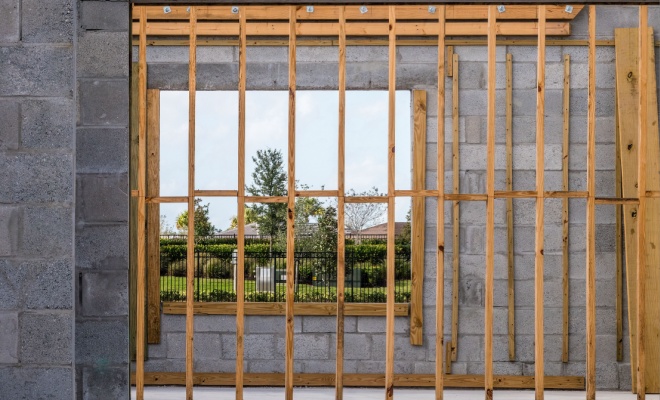
If it is discovered that the regulations were not followed, you might be required to return the space to its former state, which might cost you some money.
That said, the regulations that need to be followed are as follows:
- Ensure that there is a window in each of the new rooms to make escape easier in case of a fire. Also, the wall should be protected against fire to prevent swift spreading in case of an emergency.
- Sound insulation might be required so as to prevent potential inconvenience.
- Each new room must be well-ventilated so that there is adequate comfort for the occupants of either room.
There might be a few other things to consider, but in the above, we have highlighted the most important.
Cost of Stud Wall Removal
There are a few reasons you might want to remove a stud wall, including if you want more space, or if there is a problem with the current wall.
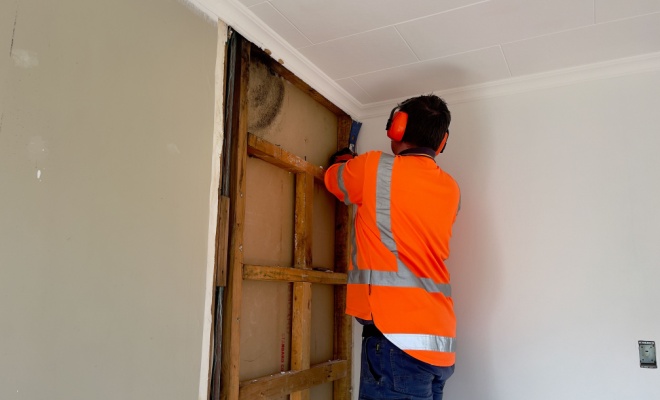
Removing a stud wall probably needs the attention of a professional and would cost anything from £1,200 to £1,750.
FAQs
It should be noted that walls that contain plumbing and pipes should be thicker.
This is because solid walls have to be built directly above existing solid ground floor walls.
They are typically used when hanging stuff on the wall to find the optimal location.
Also, there are two types: magnetic and electrical stud finders.
Different materials available for soundproofing include acoustic mineral wool and acoustic plasterboard. Often, these are combined to create multiple barriers to sound travel. Adding resilient bars and ensuring all gaps are sealed will further improve performance. If soundproofing is important for your new studded wall, you'll need to plan ahead before installation.
If you use wood screws and fix directly into the studded wall, you can hang items of up to around 50kg to the wall. This covers most electronics and furnishings you might want to attach to your interior wall.
How to Find and Hire a Stud Wall Installer
Finding a stud wall installer isn’t too difficult, and there are several websites that help you out in this regard.
That said, it is important to ensure that the person you engage is qualified for the job.
Therefore, you should ask how much experience the person has and what accreditations they have.
Also, you can engage companies that have a roster of professionals as they generally tend to have vetted work people on their books.
Sources
https://www.planningportal.co.uk/permission/common-projects/internal-walls/what-building-regulations-apply-to-internal-walls
https://www.insulation-info.co.uk/wall-insulation/internal-wall-insulation










